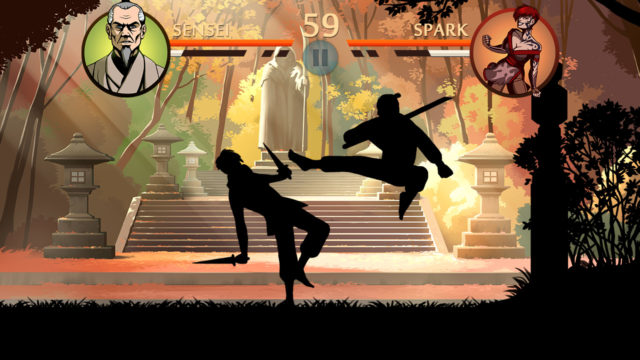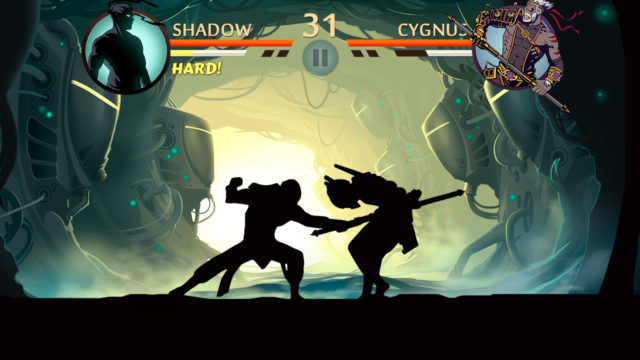Great visual style; a unique and deliberate approach to fighting mechanics; plenty of weapon options with different feels and strategies
Too much randomness thanks to RPG mechanics; repetitive story mode; uninteresting plot
While the Switch fighting game scene will undoubtedly be dominated by Smash Bros. Ultimate in the near future, there’s still plenty of time to try out some other digital brawlers while you wait. One option is Shadow Fight 2. While some might be put off by its mobile origins, there are actually a few interesting things going on in the game that make it worthy of at least some attention.
The most standout thing about Shadow Fight 2 is actually its aesthetic which features the two combatants as silhouettes against some mostly good looking and colorful backgrounds that look like they could have been taken from a graphic novel. While a few might lament that the well-done character art featured elsewhere in the game isn’t brought to full, animated life thanks to this direction, this choice ultimately gives the game a strong, refreshing sense of identity. It’s also worth noting that those animations help enhance not just the visual experience, but the gameplay as well.
While the art direction is Shadow Fight 2‘s defining feature, its actual mechanics also deviate a little from the fighting genre norm. Most attacks and movements will likely feel pretty slow for most fighter veterans, but this is done quite intentionally as the developers obviously chose to put a great deal of focus on fewer, more deliberate actions instead of fast, flashy combos. Most moves are slow enough that skilled players will be able to reasonably read their opponent’s attacks and react accordingly. Of course, the flip side to this is that bigger, stronger, and slower moves require more commitment and a grain of hope that you won’t be countered. Different weapons feature different attack strengths and speeds, but the general gist of the move set remains consistent and you also have access to a universal set of kick attacks regardless of weapon choice. It’s also nice to see a game like this give bonus damage when your strike connects with your foe’s head. Despite this slightly different approach to combat, the controls should feel pretty familiar as your basic weapon and kick attacks are modified by holding certain directions or making particular moves on the joystick. However, compared to other fighters, I did feel Shadow Fight 2 was more prone to misreading my attempts at certain direction attacks as jumps or dodges.

These mechanics are as described in the game’s Sparring mode, which is where you will also find local multiplayer, but the game’s major focus is on its story mode, where these basic ideas are expanded with additional mechanics. This mode adds in some light RPG touches in the form of three types of equipment: weapons, armor, and headgear. Weapons affect your attack strength, speed, and range while the latter two items change your overall defense. Fighting through the story earns both gold and gems which can be used for purchasing or upgrading gear, though some items come with additional perks. For armor, this might include limited healing possibilities, while weapons sometimes get bonuses to critical hits or poisons that might apply a short damage over time. These features add a nice since of customization to the game and the slow unveil of new gear encourages experimentation as you decide if you prefer slower, hard hitters like the katana or faster, weaker weapons like dual knives. Unfortunately, this feature has another edge to it.
Randomness is a common mechanic in RPGs as you often have to worry about RNG rolls going on in the background for a number of mechanics, but it doesn’t translate as well to a fighting game. Enemies also come equipped with their own perks and abilities and the same bonuses that can randomly make things much easier for you can also hit you just as hard. For example, the first boss has two possible ways to deal extra damage when he strikes you, including the aforementioned poison as well as an exploding bomb. Furthermore, these two effects can sometimes apply together from a single hit, meaning one blow in the opening second of a fight might immediately drain nearly half of your health. Of course, the fates sometimes smile in your favor as well, but when you consider the slow, deliberate nature of the combat, this extra layer of randomness seems out of place. I like the idea of customizing your character to your own style, but the implementation is hampered by this decision.
Regardless of this issue, combat generally remains enjoyable, but it does eventually run the risk of growing quite monotonous. Shadow Fight 2 features a gameplay loop of fighting to gain experience so that you can raise your level, which then unlocks gear, which then makes tougher foes more manageable so you can fight them for more experience so you can unlock more gear, and so on and so on. The problem here is that in order to challenge the boss of each stage, you have to partake in lots of less consequential fights throughout this ongoing loop. By the time you take out the boss, you’ll have fought in dozens of very similar fights and then you’ll have to do it six more times across the rest of the game’s stages. Even if you enjoy the core combat, there’s a good chance that you might find this a bit too much.

While it’s worth mentioning that there is a story driving the action, the plot itself isn’t really all that interesting. When you boot up the game, you’re shown a cool, animated cut scene showing how your character was reduced to a shadow after his hubris led him to unleash seven evil demons upon the world, but after that the story is really just a scaffolding for the gameplay loop. You do meet some mildly interesting characters along your journey and some have backstories you can explore, but none are really any more compelling.
Shadow Fight 2 is a game with quite a bit to like, a fact that seems to only exacerbate its disappointments. Thanks to the unique art direction and slower, more deliberate gameplay, the game has a great sense of identity that makes it standout. However, that different approach to gameplay is hampered by RPG mechanics that should have created a nice layer of customization but instead introduce too much randomness to what should be a more skill-based experience. Also, the fact that the story mode is incredibly repetitive while the rest of the game ultimately feels pretty anemic doesn’t help much, either. All that being said, Shadow Fight 2 is a solid game at its core and some might be able to dig through, or even appreciate, the flaws around it to really enjoy everything it does well. Unfortunately, I don’t think the majority will have the necessary patience.
Nintendojo was provided a copy of this game for review by a third party, though that does not affect our recommendation. For every review, Nintendojo uses a standard criteria.




 ShareThis
ShareThis





